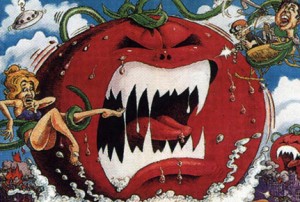Billions of acres of genetically modified crops can't be wrong, right?

 It's springtime in South America and just last week, somewhere on that green continent, a farmer planted the world's 3 billionth acre of Genetically Modified (GM) crops, signaling another milestone in biotechnology's steady ascent toward conventionality. This is celebrated news for biotech companies like Monsanto, but it's been received as a gloomy portent by farmers who've invested big in the promises of GM crops only to discover the harsh truth about Big Ag's zero-sum game.
It's springtime in South America and just last week, somewhere on that green continent, a farmer planted the world's 3 billionth acre of Genetically Modified (GM) crops, signaling another milestone in biotechnology's steady ascent toward conventionality. This is celebrated news for biotech companies like Monsanto, but it's been received as a gloomy portent by farmers who've invested big in the promises of GM crops only to discover the harsh truth about Big Ag's zero-sum game.
The biotech-friendly group Truth about Trade & Technology (TTT) provided the 3 billion acre figure in a news release last Friday. For years, the American-based non-profit organization has kept track of biotech-crop acreage by compiling official data from governments across the world.
“How big is 3 billion acres? It’s bigger than the Amazon rainforest. It’s bigger than all of Brazil. It’s big enough to say with absolute certainty that biotechnology is now a thoroughly conventional variety of agriculture,” says TTT.
Indeed, GM seeds have penetrated conventional markets to the extent that 15.4 million farmers planted these crops on 365 million acres around the world in 2010 alone. Not bad for a product that was non-existent over a decade ago and that has set itself up as a direct competitor to mother nature herself.
Proponents of patented plants make pretty lofty claims about them: that through them, farmers get paid more, yields increase and petrochemical applications are reduced. A talking point that biotech apologists often rely upon is that current world population levels could not be sustained without GM crops.
In actuality, all of the “facts” mentioned above are hotly contested, and there is evidence supporting both sides of the argument (in the interest of fairness, it is important to note that biotech firms provide the vast majority of funding for all research performed on GMOs – Genetically Modified Organisms). But there are food producers out there who don't buy all of the hype, mainly because they've experienced the brave new world of GM farming.
In a short documentary film, agriculturalist/researcher Michael Hart interviews a number of farmers from across the country who tell him that GM crops don't live up to their promised potential. In fact, given enough time, GM crops are bound to disappoint, they say. Among complaints by farmers is that GM crops require increasingly more pesticide and herbicide applications to maintain their viability. Biotech crops that have built-in glyphosate resistance tend to harbor fields of "superweeds" – weeds that have transgenically assumed the herbicidal immunities of the cash crop around which they grow, driving some farmers to remove them by hand. Across the board, farmers have taken issue with escalating prices for seeds, pesticides, and herbicides. Remember, patented seeds must be bought year after year and cannot be saved under penalty of law. These circumstances work to trap farmers within the biotech system. Once caught, farmers watch helplessly as the price of seeds and sprays outpaces crop prices.
Then, there is the scariest issue of all for farmers: if patented GM crops are “substantially equivalent” to conventional ones like the FDA says, that means the two can reproduce together (a frightening reality witnessed in a train of patent-infringement lawsuits brought against farmers unlucky enough to have their conventional crops within wind-pollination range of biotech-owned plants). It's hard to fathom a state of coexistence between patented plants and non-patented plants when the former has a proven track record of being an unchecked invader/occupier of the latter.
Part of the reason that GMOs have been allowed to develop and prosper in the shadows of civic discourse is that they are not required to be labeled on food ingredient lists. This has allowed GMOs to expand into most areas of agriculture (and thus take up habitation in most of our bodies) without much public attention or debate. The FDA has relied upon the philosophy of “substantial equivalence” when comparing genetically altered ingredients with their natural, whole-food counterparts. This has forced consumer and health advocates to pose the obvious question, “why are genetically altered substances allowed intellectual property protection if they are substantially equivalent to the real deal?”
Proper product labeling is the simplest, most effective route towards informed consumer consent when it comes to GM foods. If consumer and health advocacy groups have their way, California would be the first state with mandatory GMO labeling laws through a 2012 California Ballot Initiative. Over 80 percent of Californians polled support mandatory labeling. As the 8th largest economy in the world, California's labeling laws affect packaging and ingredient decisions nationwide.



